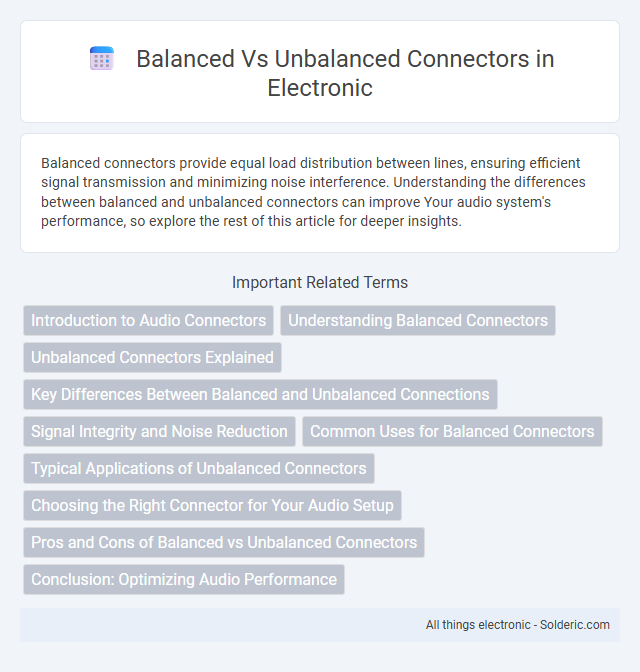Balanced connectors provide equal load distribution between lines, ensuring efficient signal transmission and minimizing noise interference. Understanding the differences between balanced and unbalanced connectors can improve Your audio system's performance, so explore the rest of this article for deeper insights.
Comparison Table
| Feature | Balanced Connectors | Unbalanced Connectors |
|---|---|---|
| Signal Type | Differential (two signal wires + ground) | Single-ended (one signal wire + ground) |
| Noise Rejection | High (common-mode noise canceling) | Low (more susceptible to interference) |
| Typical Connectors | XLR, TRS (Tip-Ring-Sleeve) | TS (Tip-Sleeve), RCA |
| Use Case | Professional audio, long cable runs | Consumer audio, short cable runs |
| Cable Length | Up to 100 meters or more without degradation | Generally limited to short distances (~5 meters) |
| Impedance Matching | Better impedance matching, reduced signal loss | Less precise impedance matching |
| Cost | Higher cost due to complexity | Lower cost, simpler design |
| Pin Configuration | Three conductors (positive, negative, ground) | Two conductors (signal, ground) |
Introduction to Audio Connectors
Audio connectors are classified into balanced and unbalanced types, each designed to transmit audio signals with varying levels of noise immunity and signal integrity. Balanced connectors, such as XLR and TRS, utilize two signal wires and a ground to reduce electromagnetic interference, making them ideal for professional audio environments. Unbalanced connectors like RCA and TS cables carry audio signals over a single conductor with a ground, offering simplicity but increased susceptibility to noise over longer cable runs.
Understanding Balanced Connectors
Balanced connectors use two signal wires and a separate ground to reduce noise and interference, making them ideal for professional audio and high-quality signal transmission. They maintain signal integrity over long cable runs by canceling out electromagnetic interference through differential signaling. Common types include XLR and TRS connectors, which are frequently used in audio equipment such as mixers, microphones, and studio monitors.
Unbalanced Connectors Explained
Unbalanced connectors use two conductors: a signal wire and a ground wire, making them more susceptible to electromagnetic interference and noise over long cable runs. Common examples include RCA and TS plugs, which are widely used in consumer audio equipment. You should consider using unbalanced connectors for short cable lengths where interference is minimal, ensuring clear audio signals within your setup.
Key Differences Between Balanced and Unbalanced Connections
Balanced connections use two signal wires and a ground, reducing noise and interference for clearer audio transmission, while unbalanced connections use a single signal wire and ground, making them more susceptible to electromagnetic interference. Balanced connectors, such as XLR and TRS, are commonly used in professional audio environments requiring long cable runs, whereas unbalanced connectors like TS and RCA are typically found in consumer electronics with shorter distances. Understanding these key differences helps you choose the appropriate connector to maintain signal integrity in your audio setup.
Signal Integrity and Noise Reduction
Balanced connectors, such as XLR and TRS, use two signal wires with opposite polarity, which significantly enhances signal integrity by canceling out electromagnetic interference and reducing noise. Unbalanced connectors, like RCA and TS, carry signals on a single wire with a ground reference, making them more susceptible to noise and signal degradation over longer cable runs. For critical audio applications requiring superior noise reduction and signal clarity, balanced connectors are preferred due to their ability to maintain high fidelity and minimize hum and interference.
Common Uses for Balanced Connectors
Balanced connectors, such as XLR and TRS cables, are commonly used in professional audio environments, including recording studios, live sound setups, and broadcasting, to minimize noise and interference. These connectors transmit audio signals as differential pairs, which significantly reduces electromagnetic interference over long cable runs, ensuring clear and crisp sound quality. Your audio equipment benefits from balanced connectors when precise, high-fidelity sound reproduction is critical, especially in environments with substantial electrical noise.
Typical Applications of Unbalanced Connectors
Unbalanced connectors are commonly used in consumer audio devices, such as electric guitars, DJ equipment, and home stereo systems, where short cable runs minimize interference. These connectors, including RCA and TS plugs, suit applications requiring simple, cost-effective connections without professional-grade noise isolation. Your setup benefits from unbalanced connectors when durability and ease of use outweigh the risk of signal degradation over longer distances.
Choosing the Right Connector for Your Audio Setup
Balanced connectors, such as XLR and TRS cables, provide noise reduction and signal integrity ideal for professional audio setups and long cable runs. Unbalanced connectors like TS and RCA are simpler and more cost-effective, best suited for short distances and consumer-grade equipment. Selecting the right connector depends on the specific audio environment, cable length, and desired sound quality, with balanced connectors favored in studio and live sound settings for their superior noise rejection.
Pros and Cons of Balanced vs Unbalanced Connectors
Balanced connectors offer superior noise rejection and signal integrity, making them ideal for professional audio environments and long cable runs. Unbalanced connectors are simpler, more cost-effective, and suitable for short distances but are more susceptible to interference and signal degradation. Choosing the right connector depends on your application's need for noise resistance and cable length.
Conclusion: Optimizing Audio Performance
Optimizing audio performance requires selecting balanced connectors for superior noise rejection and signal integrity, especially in professional audio environments. Unbalanced connectors may suffice for short cable runs and consumer applications but are more susceptible to interference and signal degradation. Prioritizing balanced connections ensures clearer sound quality and reliability in complex audio setups.
Balanced vs Unbalanced connectors Infographic

 solderic.com
solderic.com